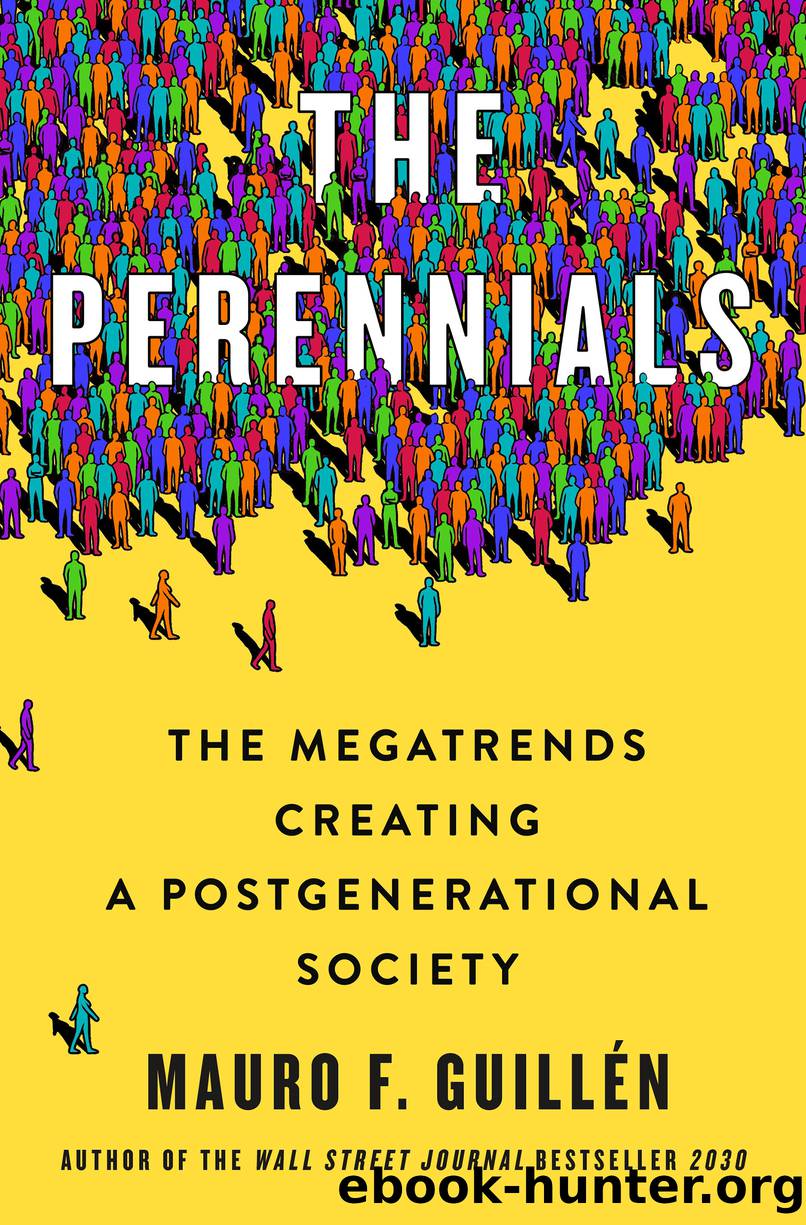The Perennials: the Megatrends Creating a Postgenerational Society by Mauro F. Guillén

Author:Mauro F. Guillén
Language: eng
Format: epub
Publisher: St. Martin's Publishing Group
TECHNOLOGY AND WORK FOR SENIORS
Consider how technology is changing what work tasks we do as human beings. Jane Falkingham, a gerontologist at the University of Southampton, argues that manual hard labor is increasingly being performed by machines or robots. âItâs changing the nature of work, which will facilitate people working longer as well.â
Advocates of age diversity and inclusion in the workplace believe that technology erases the disadvantages of aging and unleashes the potential of a multigenerational workplace. âOlder employees in your team have a lot of value to give. They can look at tasks from a different perspective to your younger team members. They are also excellent mentors to the new generation,â argues Lisa Michaels, a freelance writer, editor, and marketing consultant. For her, simple, easy-to-use software solutions based on AI can help people in their sixties and beyond adapt to changes in workplace technology and reduce errors in repetitive tasks, and thus help these workers focus on what they can do best. âGetting intelligent machines to complete repetitive tasks for older employees means that they can spend more time on creative, meaningful tasks.â She strikingly proposes to use the Internet of Things (IoT)âall those connected devices and sensorsâin a way that âa younger worker could access information directly from an older worker with more experience. In a mentoring situation, IoT can help mentors deliver guidance even when theyâre not physically present to train younger employees.â She envisions situations in which âif something goes wrong for the trainee, the older employee would be able to step in and take control of the situation.â She also proposes that data analytics might help track the impact of different work styles and perspectives in a multigenerational workplace.
But the most tantalizing opportunities lie in the new technologies for remote work and learning. To the extent that retirement is all about not having to be on a fixed schedule, including the commute to the job, then remote work may well come to represent the best opportunity for people beyond the age of sixty to work flexibly and joyfully, and for companies and the economy to benefit from their experience. Likewise, remote learning can help with the transition to postretirement work and with switching jobs and careers.
The AARP sees several big opportunities in remote work for older workers. As companies ponder where to strike the balance between remote and office work, the expectation is that blended work âwill almost certainly prove to be a huge boon for millions of older employees in the months and years to come.â The regimented five-day-per-week, eight-hour-per-day work schedule, with the associated stress and tiredness from commuting, is a leading reason for people to desire early retirement.
Remote work has the ostensible disadvantage of eliminating social interactions at the office, but it removes a major point of dissatisfaction. Even before the pandemic, flexible work options were becoming increasingly popular. In 2019, FlexJobs reported that 75 percent of workers wished to switch to a more flexible arrangement on consideration of work-life balance (75 percent), family (45 percent), time savings (42 percent), and commute stress (41 percent).
Download
This site does not store any files on its server. We only index and link to content provided by other sites. Please contact the content providers to delete copyright contents if any and email us, we'll remove relevant links or contents immediately.
Hit Refresh by Satya Nadella(9039)
The Compound Effect by Darren Hardy(8811)
Change Your Questions, Change Your Life by Marilee Adams(7635)
Nudge - Improving Decisions about Health, Wealth, and Happiness by Thaler Sunstein(7615)
The Black Swan by Nassim Nicholas Taleb(7010)
Deep Work by Cal Newport(6880)
Daring Greatly by Brene Brown(6447)
Rich Dad Poor Dad by Robert T. Kiyosaki(6405)
Principles: Life and Work by Ray Dalio(6217)
Playing to Win_ How Strategy Really Works by A.G. Lafley & Roger L. Martin(5927)
Man-made Catastrophes and Risk Information Concealment by Dmitry Chernov & Didier Sornette(5921)
Digital Minimalism by Cal Newport;(5664)
Big Magic: Creative Living Beyond Fear by Elizabeth Gilbert(5614)
The Myth of the Strong Leader by Archie Brown(5425)
The Slight Edge by Jeff Olson(5349)
Discipline Equals Freedom by Jocko Willink(5285)
The Motivation Myth by Jeff Haden(5156)
Stone's Rules by Roger Stone(5026)
The Laws of Human Nature by Robert Greene(5000)
